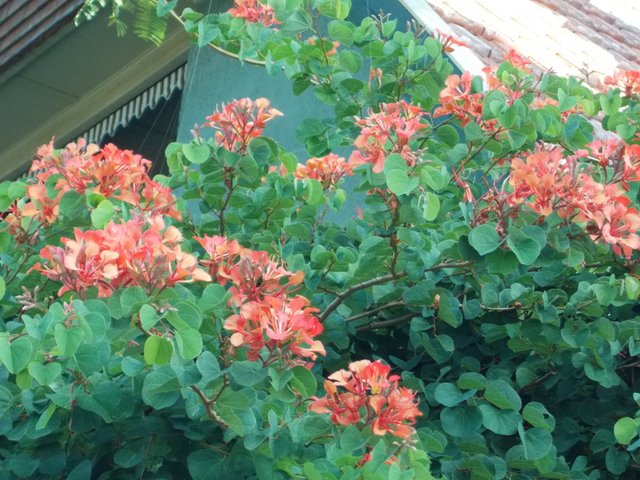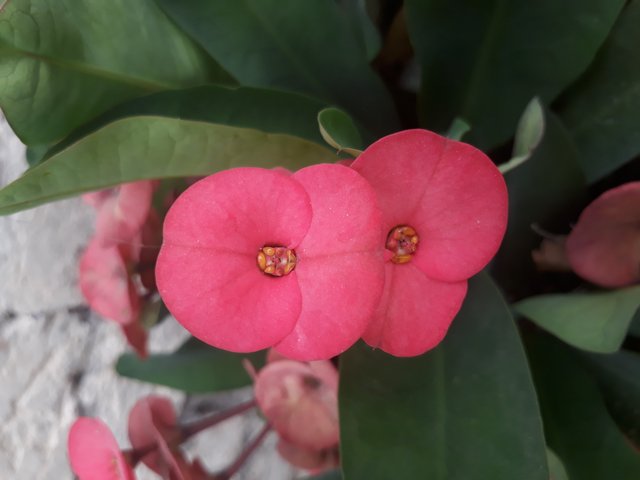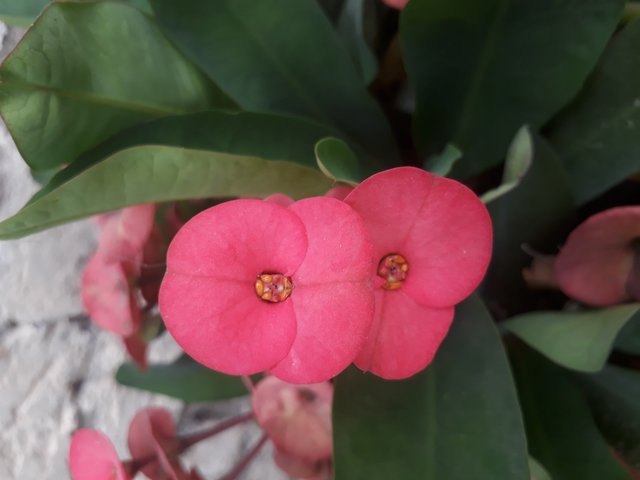Red Bauhinia - a warm colour during winter.
The spectacular Red Bauhinia , ( Bauhinia galpinii ) is adding it's warm colour to the winter cold here in Sydney. This is a large shrub or small tree, growing around 3 to 6 metres high. It is native to Africa and thrives in temperate to warm climates. Red or orange flowers ( depending on the variety ) cover the tree, but the green lobed foliage is also very attractive, being similar in shape to a Camel's foot. Birds are attracted to the flowers for the nectar, so this is a good plant for wildlife lovers. This tree was growing in one of Sydney's local gardens.

Beautifull photography

I also take these picture a few days ago
Hope you like it.
Yes, very nice. It looks like Euphorbia, does it have thorns?
Yes it have thorns.
@ctrl-alt-nwo, This is wanna most impressive plant introduction my friend. Most fabulous flowers indeed those plant. I prefer to read your another gardening post and I add some more information through another web.
In its wild state this medium to large shrub behaves more as a climber, clambering through the trees and shrubs of the dense thicket vegetation in which it occurs. It doesn't have to be grown in this fashion in your garden and with just a little pruning and training it can easily be trained into an attractive small tree or large garden shrub. Alternatively it can be encouraged in its clambering habit to cover pergolas or other structures and offer evergreen shade in your garden.
As the name suggests, anyone could be forgiven for thinking that this plant comes from the Cape. In actual fact it is named after the De Kaap valley, south of Nelspruit in Mpumalanga in the northeastern region of South Africa. It is much more widespread, however, and can be found right across the moister bushveld areas of the country.
Thanks for your valuable content.
Source: http://pza.sanbi.org/bauhinia-galpinii
Congrats, you got the Silly Sausage Award for your great comment. Well done.
Thanks your consider to mine.
A shrubby plant that often climbs into surrounding trees and reaches up to 5 m or more in height. Its younger branches are finely hairy while the older stems quickly become hairless. Its broad leaves (2-7 cm long) have two rounded lobes at the tip and are often folded lengthwise. Its orange to dark red flowers have five have five large petals (2.5-5 cm long) with narrow bases and broad rounded tips. Its large elongated pods (8-13 cm long and 18-28 mm wide) turn dark brown in colour as they mature.
The younger branches are finely hairy (i.e. puberulous) while but they quickly become hairless (i.e. glabrous). The alternately arranged leaves are borne on short stalks (i.e. petioles) 5-23 mm long. They are often folded lengthwise and are butterfly-like in appearance. Their upper surfaces are hairless (i.e. glabrous), while their undersides are sparsely hairy (i.e. puberulent).
Flowering branches and flower stalks (i.e. pedicels) are densely covered with tiny brownish coloured hairs (i.e. they are pubescent). The individual flowers are borne on stalks only 2-5 mm long, but the base of each flower forms a narrow stalk-like tube (i.e. hypanthium) 17-32 mm long that is obscurely to conspicuously ribbed lengthwise.
Source
Congrats, you won the Fav. comment Award for your great comment. Shared with one other.
Thank you! I have posted Lantana flowers, please have a look at my blog. :)
A shrubby plant that often climbs into surrounding trees and reaches up to 5 m or more in height. Its younger branches are finely hairy while the older stems quickly become hairless. Its broad leaves (2-7 cm long have two common names.

Also known as: red bauhinia, African orchid tree, African plume, butterfly bush, dwarf orchid tree, lowveld bauhinia, orchid tree, pride of De Kaap, red orchid tree.
KNOWN DISTRIBUTION
Occasionally naturalised in the Moreton district in south-eastern Queensland. Also recorded on a couple of occasions in central Queensland.
HABITAT
A weed of roadsides, disturbed sites, waste areas, old gardens, urban bushland, coastal environs, gullies, riparian vegetation, open woodlands and forest margins.
HABIT
A shrubby plant usually growing 1-4 m tall in cultivation. However, it often climbs into surrounding trees and reaches up to 5 m or more in height when growing in natural vegetation (i.e. it is a scandent shrub).
Thanks @ctrl-alt-nwo for sharing this post. 🤗💚
magoo-2 found a series of multi accounts of a same owner is following your articles to cheat your generous rewards.
magoo-2 found these accounts are suspicious & can be multi accounts of a single owner. Conclusion is based on last 30 days transactions:
@stardivine
@invinciblelight
@lovehaswon
magoo-2
Check our latest multi comment spam update report
Red bauhinia is a dense, semi-climbing, evergreen shrub with deeply-cleft, 2-lobed leaves that resemble the hooves of cattle (Fig. 1). The flowers of this sprawling plant are orchid-like in appearance, brick-red in color, and borne in few flowered racemes. The 1 1/2-inch-wide flowers of red bauhinia occur in the spring and summer and put on quite a show if the plant is trained on a trellis. The fruits are 5-inch-long pods that appear in the late summer, and these may be a litter problem.
Red bauhinia is nice in the landscape as an espalier, specimen, border, ground cover, and container plant. It climbs a fence nicely, producing most of the flowers near the top. It is a bit asymmetrical, perhaps even unkempt looking, making it best suited for the large-scale landscape planting.
Red bauhinia requires a location in the landscape in which it receives full sun and grows best on a well-drained, sandy loam soil. It often suffers from a deficiency of micronutrients in soil with a pH above 7. Preventive fertilizer applications help keep the foliage green. This plant requires little maintenance once it is established but may need early spring pruning or shaping for growth control.
http://edis.ifas.ufl.edu/fp061
Bauhinia galpinii, also named the African Plume, the Red Orchid Tree or the Pride of De Kaap, is named after the De Kaap valley, South of Nelspruit in Mpumalanga in the Northeastern region of South Africa. The species epithet "galpinii" honors Ernest Galpin (1858-1941), a South African plant collector. It is a Southern Africa evergreen to semi-evergreen sprawling shrub, up to 10 feet tall and 15 feet sprawl. In its wild state this medium to large shrub behaves more as a climber, clambering through the trees and shrubs of the dense thicket vegetation in which it occurs. It can be encouraged in its clambering habit to cover pergolas or other structures and offer evergreen shade in your garden. It doesn't have to be grown in this fashion in your garden and with just a little pruning and training it can easily be trained into an attractive small tree or large garden shrub. It produces its brick red flowers, 2.5 inches in diameter, for a long period from Spring to Fall. The leaves are two-lobed, grayish-green, resembling a butterfly in shape, and 2-3 cm long. The pods are straight, dark brown, 10-15 cm long and 2-3 cm broad. Hardiness zones 9-11, (-5°C/25°F, 5°C/40°F) in Winter. It is hardy to drought and moderate frost, but may need protection from frost in the first two or three years after planting. Use sandy well drained potting soil. The pride of De Kaap is easy to cultivate and requires little attention once established. Grow in full sun and procure average water.
http://www.rarexoticseeds.com/en/bauhinia-galpinii-seeds-red-orchid-tree-seeds.html
When in bloom, the nasturium-bauhinia looks like a reddish-orange bougainvillea from a distance due to its habit and profuse flowers. A semi-deciduous tree native to southeastern Africa, it grows upright, but has drooping, spreading branches that flop to the ground or on to nearby plants.
The leaves are rounded and divided into two lobes like other Bauhinia. They are a light to medium green and shed during the cool or lightly frosty winter season. The five-petaled flowers bloom most heavily in spring, but recur sporadically through summer and early autumn. Each blossom is red-orange to salmon with five claw-like petals. Hummingbirds and butterflies visit these blooms; this only occasionally leads to seed pod production.
Grow nasturium-bauhinia in full to partial sun and fertile, well-drained soil. It is fairly drought tolerant once established. Plant in acid to neutral soils for best health. Alkaline soils can cause nutrient deficiencies and leaf yellowing. This tropical small tree is best grown in areas where summers are moist and winters cool and dry. It will be killed back to the roots by winter cold in USDA zone 8 but will rejuvenate each spring. These plants also maintain a more shrubby habit.
http://www.learn2grow.com/plants/bauhinia-galpinii/